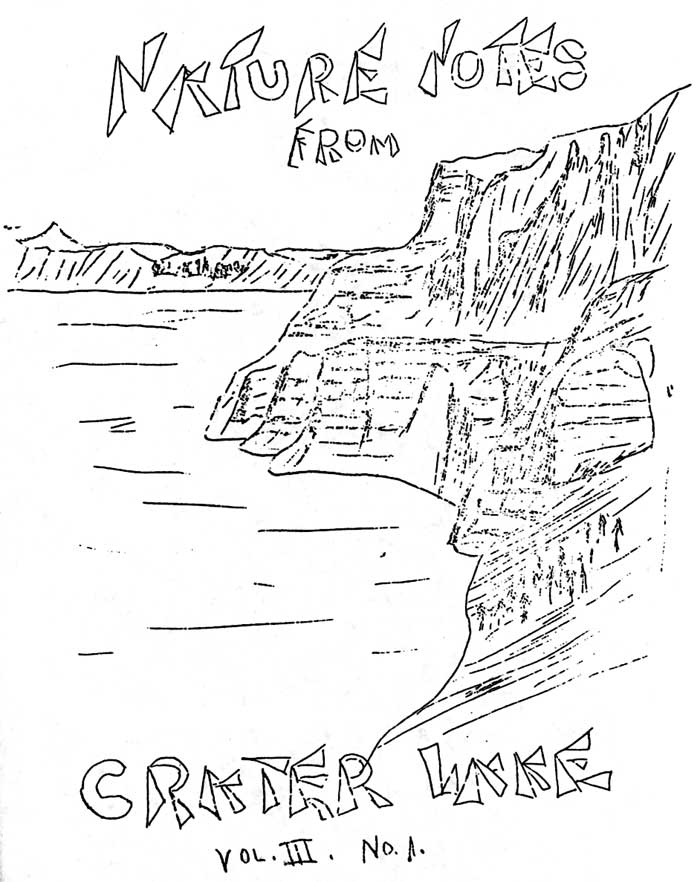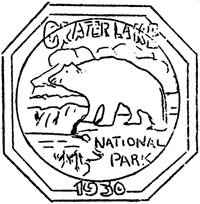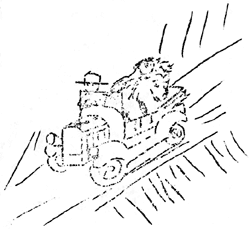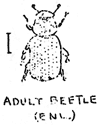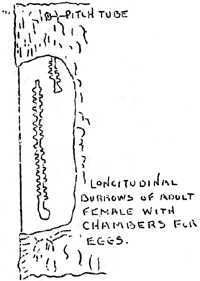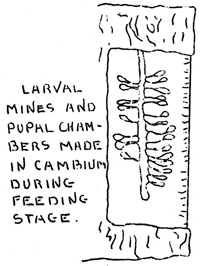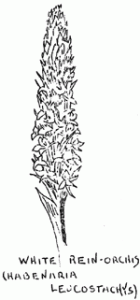Volume 3 No. 1 – July 1, 1930
All material courtesy of the National Park Service.These publications can also be found at http://npshistory.com/
Nature Notes is produced by the National Park Service. © 1930.
Greetings From Crater Lake National Park: 1930
By Earl U. Homuth, Acting Park Naturalist
“Climb the mountains and get their good tidings. Nature’s peace will flow into you as the sunshine flows into trees. The winds will blow their strength into you, and the storms their energy, and cares will drop from you like autumn leaves.”
Quotation from John Muir.
To our many friends scattered throughout the land, to those whose good fortune it has been to visit Crater Lake National Park, and to those whose pleasure still lies in anticipation, we extend greetings.
The season gives every indication of success. A light, late-season snowfall was soon cleared, and the camp grounds were bright with the campfire of visitors long before the official opening date, July 1.
The staff of the Educational Division has been again augmented and we wish to introduce Mr. F. Lyle Wynd, who has, during five years study in the Park, completed a “Flora of the Park”, soon to go to press; Mr. Norman Ashcraft for five years a ranger in the park; and Mr. Clyde Gilbert, a student of Geology, from Eugene, Oregon.
Triplets
By F. Lyle Wynd, Ranger Naturalist
Regularity and efficiency in the Administration of Crater Lake National Park is having far reaching results.
At one time the bears were so few in the Park that it was feared that Bruin’s portrait on the windshield stickers would soon fail to have any significance. It was in the Spring of 1919 that the bear situation took on a new aspect.
At this time, a long, starved-looking she-bear put in her appearance. There were other bears to be sure, but a strange coincidence of fate was to make this unpromising looking lady the forerunner of all the bears now commonly seen about Park Headquarters.
Her first season in the Park she brought in two cubs, Jim Jeffries and Jack Johnson. Owing to a slight error on the part of those doing the christening, Jim Jeffries later had her name changed to Jemima. By popular consent Jack Johnson became Buster.
Maggie, for this was the lady’s name, was to have a short career. In 1920, scarcely a year from the time she had placed her confidence in human beings, she wandered to a logging camp some distance from the Park boundaries. Trusting that all the world was like Crater Lake, she sat down before a tent and waited to be fed. In an instant it was over. The inhabitant, being a true sportsman, shot her dead. It is probable that even now certain gentlemen are telling heroic tales before an open fireplace with their stocking feet comfortably buried in a soft bear rug.
But all was not lost, for Maggie had already done her bit for Crater Lake.
In the best of families there are things better left unsaid, but for the sake of scientific accuracy, it must be related that Maggie’s son, Buster, came to a bad end. He grew to an enormous and beautiful brown bear, but his temper was cross and uncertain. As he grew older, he became fatter and crosser. He was finally executed as a measure of public safety.
But with Jemima, Buster’s sister and Maggie’s daughter, things went differently. She also grew large and beautiful, but her temper as vastly different from her big brother. She became very tame and gentle and for many season she has been a constant source of amusement and wonder to the visitors at Crater Lake. She was very often to be seen curled up on the back porch of the cook house at Park Headquarters snoozing blissfully, awaking occasionally to receive tid-bits from the cook.
In 1921 Jemima came to camp with two cubs. They were promptly named Hans and Fritz. In alternate seasons with clock-like regularity Jemima, or Jimmy as she is now called, brings a pair of furry youngsters to Park Headquarters for christening.
Fritz, one of Jemima’s first cubs, was true to his masculine instinct, and soon wandered away to a new stomping ground. He has not been seen since.
His twin sister, Hans, followed the footsteps of her mother. She remained at Crater Lake, and became extremely tame and gentle. She was photographed and fed, and petted until finally, one thing leading to another, she became nationally famous. At the tender but robust age of two years the qualities of her genius were broadcast over Radio Station K. G. O. One newspaper after another published articles and pictures of her, but all this made no difference to her. She had already determined that her career was to populate Crater Lake National Park with bears.
Her first children came in 1926. Realizing the importance of her position, she had triplets. She trusted all humans insofar as she herself was concerned, but she did not trust their baleful influence on her cubs. Only in the later part of the season when they were of good size, and able to take care of themselves did she bring them into headquarters.
Again in 1928, Hans presented the Park with triplets. One of these has evidently disappeared.
In the spring of 1930, it was a subject of much discussion among the rangers and other employees of the park as to the probable showing Hans would make this season.
In the later part of May there was great excitement at Park Headquarters. Just at dusk someone shouted, “Hans, Hans!!” In a moment the entire government force, from the superintendent to the bull cook were screaming about, “Where, Where?”
“Behind the blacksmith shop!”
Sure enough there was Hans, a little the worse for the winter’s duties, but the cubs — where were they? Where else, but up a tree.
The cook hurriedly obtained a bucket of meat scraps for the mother, and with the craning of many necks, three furry, black balls were finally dimly descried through the gathering dusk in the very tops of those different mountain hemlock trees. At last Hans had discovered that National Park humans were different from many others. She now trusted them enough to bring her tiny babies almost as soon as they could walk.
The dusk became black night, and still the entire population of Crater Lake stood knee deep in snow with clattering limbs, peering at the now partly visible youngsters. They were whimpering softly to each other in the tree tops, when the admiring crowd dispersed. Judging from the exclamations of the mother and quantities of affectionate baby talk lavished on the youngsters, there will be a happy family of bruins at Crater Lake this season.
Hans is probably the only wild bear known that will willfully climb on the side of a car, and wait to be taken for a ride about the camp ground. By careful work and many soft words she has been enticed into a closed car and taken for a ride. She sits in the seat rather awkwardly to be sure, but she is well behaved, and watches the passing landscape with such an extreme interest as to be almost comical.
Hans is beyond all question the best known, and best loved bear that ever gave her confidence to people of Crater Lake Park.
While those familiar with the habits and individual tempers of wild bears may do many wonderful things with them, it should be not inferred that they are as gentle and harmless as domestic animals. It is always dangerous for tourists to attempt even to feed the bears.
Bobby Has Moved
By Earl U. Homuth
Bobby no longer inhabits the rock and wood pile near the lodge. He has taken up quarters near the Information Bureau on the Rim.
Bobby may be less conspicuous than Jemima or some of the Park bears, but certainly not less popular. The soft patter of his feet, scurrying across the floor of the Information Bureau may be the first announcement of his presence. A choice of raisins or crackers is immediately forthcoming from the ranger on duty.
His trusting nature, diminutive form, and the peculiar characteristic of a short bobbed tail by which he can be distinguished from others of the numerous golden mantled ground squirrels, endears him to visitors and rangers alike. Others of his kind may be just ground squirrels, but Bobby is a friend and pet of all.
He is certainly keeping Mrs. Bobby, and the family well supplied in a nest somewhere nearby.
Bugs!
By Earl U. Homuth
(This is the first of a series of articles dealing with the work of control or eradication of a bark beetle (Dendroctorius Monticolae, Hopk) which threatens to destroy the Pine forests of the park and surrounding areas. This, the Solar method of control, was developed in Crater Lake National Park, has passed the experimental stage, and will probably be introduced into other parks or areas where similar infection occurs. Materials for these articles, covering the various phases of the work, have been very kindly presented by Chief Ranger Godfrey, Park rangers, Stetson and F. Solinsky, Ranger Naturalist F. L. Wynd; and information on the life history is from the Park Manual of Information section on Forest Insects prepared by Mr. J. E. Patterson.)
Concerning the Control and Eradication of the Mountain Pine Beetle
By Godfrey, Stetson, Solinsky, Wynd, Patterson
A line drawn east and west through the center of Crater Lake National Park, has become of interest, not alone to the Park Service, but also to every forestry institution and person interested in the conservation of our forests. That line represents the encroaching outpost of a vast army of predatory insects which are destroying the forests of the Cascade Range.
North of this line lies an area of somewhat unfertile lands covering over 33,000 acres, in which practically the entire forest is dead, excepting a few stands of fir and of hemlock. The greatest percentage of the forest cover was lodgepole pines, and over 90% of these are destroyed, excepting, again, such trees as are less than six inches in diameter.
South of this line, is an intermediary section, covered with the same timber, two to three miles wide, in which the trees have been attacked.
Extending indefinitely southward, from this intermediary section, mixed with the deep forests of Mountain Hemlock and first, are the Western White Pine and Yellow Pines, the standing living forest of incalculable value, which is threatened by this invasion.
The infection appeared in the northern area about 1915 and since that time, as mentioned, has destroyed the entire stand of pines. Since 1920 this same insect has been developing in areas south of Crater Lake. The Park Service has expended considerable sums in an effort to destroy the beetle and preserve the forest.
In the spring of 1925 anxiety crystallized into action. Of the remaining pine forest stands, the entire timbered area of the park was threatened with destruction which seemed beyond control. The situation was brought before public and governmental attention and as a result, preliminary measure were begun largely with the object of finding what could be done to prevent the parasite from spreading into the Yellow Pines which covered the southern portion of the park, and which composed the most valuable timberland, both from a scenic and permanent standpoint. The efforts yielded little encouragement. The future held visions of another “silver forest”, gaunt skeletons of trees stripped in time of their bark; an area of desolation similar to that in the north, creating in the form of greater fire hazard, a menace to the new growth which might otherwise by natures plan conceal the desolation.
The insect causing this great destruction, the mountain pine beetle (Dendroctorius monticolae, Hopk) is about the size of a grain of wheat, cylindrical in shape and black in color.
The egg is very small, and pearl-white. The larva, full grown is also about the size of the adult, white, cylindrical, slightly curved and has a broad head; the pupa is almost of similar size; the newly formed young beetle is brown.
The beetle attacks many species of coniferous trees; in the park it attacks and kills the lodgepole pine, white pine, sugar, yellow and mountain white bark pine and the Engleman spruce. Larger and older trees are prefered, and the trunks and base of larger limbs of these although even saplings are attacked.
The fatal effect upon the tree is due to the life habits of the insect. The adult enters to the cambium, or living layer of the tree, by boring entrance holes through the outer bark. After entrance to the cambium layer, longitudinal galleries of some length are excavated on the surface of this sapwood, an in niches along the sides of these galleries the eggs are laid.
When the grub, or larva hatches, it feeds upon the cambium tissue, horizontally. The effect of the brood of one beetle might be negligible, but when many have entered, the tree is, by these many larvae feeding somewhere throughout its girth from just above ground to the largest branches, completely girdled in its very life tissue.
The season of activity of this beetle varies somewhat with elevations and climatic conditions. In Crater Lake National Park, the activity usually begins early in May and continues to September. Beetles which have wintered in trees begin to emerge in June, and this continues until August. New trees are of course attacked during this period and until late in August. The larvae hatch during early July, and continue to hatch and feed until late in September. With the advent of winter conditions, they become dormant in various stages of development, including some parent adults. Activity is resumed early in May. The parent adults lay eggs and these larvae, together with those which were dormant during the winter, feed until early June, when pupation takes place. The new adults emerge during July and August, thus completing the life cycle.
When an adult beetle enters a tree, the dust of its boring falls from the entrance holes and lodges in the bark crevices or is found upon the ground. Soon resin exudes from these holes, forming pitch tubes, which are very obvious and are unmistakeable signs of infestation.
The needles of the tree soon turn a yellowish white; and from two to eight months later, brick red. The tree is then dead, and partially dried out. By the end of July after the year of attack, the bark is marked by numerous circular holes, about 1/16 inch in diameter. These are the exit holes by which this new brood emerge from the tree. During the succeeding fall and winter, the needles fall from the tree; by the third year the bark starts to fall and soon the stark, bare trunk and limbs are exposed and the ghostly bleached trees form the “ghost forests” or “silver forests” found in various localities.
Orchids
By F. Lyle Wynd
“Is that a real orchid?”
“Yes, a real orchid, and eight other kinds also grow in Crater Lake National Park.”
Orchids have so long been known to the public as queer exotic things in the windows of expensive floral shops that the tourist is very often amazed to find that many different kinds grow in the woods. Many of these native species, while not so large and showy as the cultivated forms, are as beautiful as those sold for a very high price by the florist. Each has the characteristic shape of flower and delicate coloring that has made the orchid the most admired flower in the world.
In Crater Lake Park there are nine species of native orchids, belonging to six different genera.
The Mertens’ Coral Root and the Spotted Coral Root are very common in the Hemlock woods of the Hudsonian Life Zone. These two species are thought to hybridize among themselves, which gives rise to many variable forms.
The Northwestern Twayblade is a delicate greenish flower also rather common. It has the widest range of any orchid in the Park, being found in considerable numbers in the Lodgepole Pine forest and the Hemlock forest.
The Slender Bog-orchid, the Boreal Bog-orchid, and the White-flowered Bog orchid form a closely related group. The first named species has green flowers, while the latter two are white. They grow along the streams and in swampy places throughout the park area.
The Alaska Piperia is an inhabitant of the Yellow Pine forest of the lower altitude. It has greenish-white flowers arranged in a long terminal spike.
The Hooded Ladies’ tresses, having a short spike of pearly white flowers, is one of the rarer species of this region. It prefers the mossy streamside of the Lodgepole Pine forest.
Only this season another orchid was found by the writer. It is commonly known as the Rattlesnake Plantain. Its flowers are very inconspicuous, and one would scarcely recognize it as being an orchid. It was found in the Hemlock forest near Anna Springs.
Yes, there are real native orchids in the Park, nine different species, eight of which as beautiful as any cultivated varieties, except for their smaller size.
For those technically inclined, we include here the scientific names with their common name equivalents:
Corallorhiza mertensiana Bong. – Merten’s Coral Root
Corallorhiza maculata Raf. – Spotted Coral Root
Ophrys Courina (Piper) Rydb – Northwestern Tway Blade
Limnorchis stricta (Lindl) Rydb – Slender Bog-orchid
Limnorchis dilatata (Pursh) Rydb – Boreal Bog-orchid
Limnorchis leucostachys (Lindl) Rydb – White flowered Bog-orchid
Piperia unalaschensis (Spreng.) Rydb – Alaska Piperia
Ibidium romanzoffianum (Cham. and Schl) House – Wooded Ladies’ Tresses
Goodyera Menziesii – Rattlesnake Plaintain
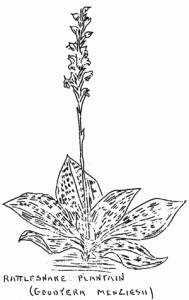 Other pages in this section
Other pages in this section


